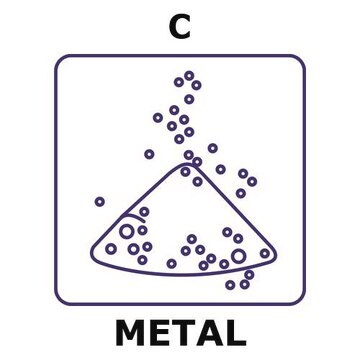633100
Carbon
nanopowder, <100 nm particle size (TEM)
Synonyme(s) :
Carbon
Se connecterpour consulter vos tarifs contractuels et ceux de votre entreprise/organisme
About This Item
Produits recommandés
Forme
nanopowder
Niveau de qualité
Superficie
>100 m2/g , BET
Taille des particules
<100 nm (TEM)
InChI
1S/C
Clé InChI
OKTJSMMVPCPJKN-UHFFFAOYSA-N
Vous recherchez des produits similaires ? Visite Guide de comparaison des produits
Description générale
Carbon nanopowder possesses excellent propertiessuch as a huge electroactive surface area, high thermal and electricalconductivity, biocompatibility, and high porosity. It is widely used in thefields of catalysis, adsorbents, electrochemical sensing, bioimaging,reinforcement filler, and renewable energy devices.
Application
Carbon nanopowder can be used:
- To fabricate anode material for a microbial fuel cell for bioelectricity generation.
- To prepare nanopowder embedded graphite paste matrix for electrochemical sensing of biologically active compounds such as raloxifene (anticancer drug).
- To enhance the electromechanical potential of polymer composites thatare used as actuators in telerobotics and medicine.
Notes préparatoires
Amorphous materials formed by laser techniques.
Code de la classe de stockage
11 - Combustible Solids
Classe de danger pour l'eau (WGK)
WGK 3
Point d'éclair (°F)
Not applicable
Point d'éclair (°C)
Not applicable
Faites votre choix parmi les versions les plus récentes :
Déjà en possession de ce produit ?
Retrouvez la documentation relative aux produits que vous avez récemment achetés dans la Bibliothèque de documents.
Les clients ont également consulté
Electrode Materials for Lithium Ion Batteries
Kam KC and Doeff MM
Material Matters, 7(4) (2012)
Edge-carboxylated graphene nanoflakes from nitric acid oxidised arc-discharge material
Salzmann CG, et al.
Journal of Materials Chemistry, 20, 314-319 (2010)
I N Kurchenko et al.
Mikrobiolohichnyi zhurnal (Kiev, Ukraine : 1993), 75(3), 12-23 (2013-07-23)
The ability of soil and endophytic strains of P. funiculosum to accumulate biomass under cultivation conditions in media containing carbon sources from mono- to polysaccharides has been studied. It has been shown that the most favorable carbon sources for the
Patrick J McCormick et al.
Biomedical instrumentation & technology, 47(4), 347-355 (2013-08-08)
Common practice when validating the cleaning of medical devices is to employ clinically relevant test soils as a challenge to the cleaning process. During use, medical devices may come into contact with a variety of materials that are difficult to
Energy policy: A low-carbon road map for China.
Zhu Liu et al.
Nature, 500(7461), 143-145 (2013-08-09)
Articles
Discover more about advancements being made to improve energy density of lithium ion battery materials.
Notre équipe de scientifiques dispose d'une expérience dans tous les secteurs de la recherche, notamment en sciences de la vie, science des matériaux, synthèse chimique, chromatographie, analyse et dans de nombreux autres domaines..
Contacter notre Service technique



